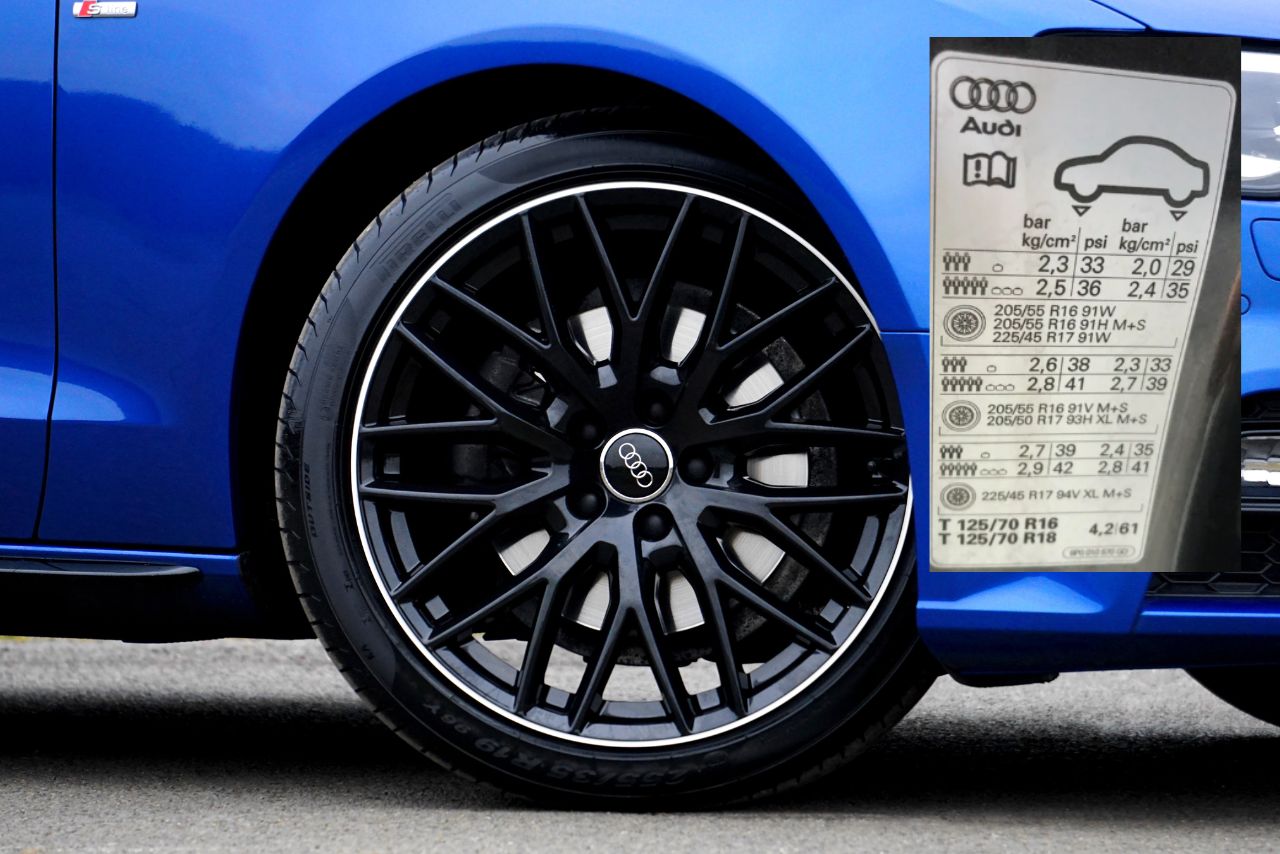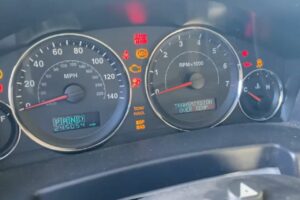Are you feeling unsure about the optimal tire pressure for your Audi A3? Whether you’re a seasoned driver or just starting out, maintaining the correct tire pressure is essential for safety and performance on the road.
Yet with different model years, trims, and OE tires to consider, it can be tough to know exactly what PSI is right for your specific vehicle.
In this article, we’ll break down everything you need to know about Audi A3 tire pressure so that you can hit the road with confidence.
From recommended ranges and checking methods to potential consequences of incorrect inflation levels – we’ve got you covered.
If the tyres on an Audi A3 are 16 inches, the recommended tyre pressure is 32 psi in the front and 30 psi in the back. However, if the tyres are 17 inches, it is recommended to have a tyre pressure of 30 psi in the front and 29 psi in the back.
Maintaining Proper Audi A3 Tire Pressure:
Maintaining proper tire pressure is crucial for your Audi A3’s performance, safety, and fuel efficiency. Driving with underinflated or overinflated tires can lead to a variety of issues such as reduced handling and increased tire wear.
Your Audi A3 owner’s manual provides the recommended tire pressures (such as 225/45R17 or 225/40R18) for each trim level so make sure to check that you are using the correct air pressure for your specific vehicle.
Also, it’s important to note that improperly inflated tires could trigger the TPMS warning light on your dashboard which indicates when at least one of the tires is underinflated.

Regularly checking and maintaining proper tire pressure will ensure that you get the most out of your premium Audi Original tires.
As per guidelines provided in your owner’s manual, use quality equipment such as a tire pressure gauge when checking tire inflation levels regularly at least once every month and never rely solely on visual inspection.
Recommended Tire Pressure for Audi A3:
It’s important to maintain the recommended tire pressure in your Audi A3 for optimal performance and safety.
| Tire Size | Front (cold) | Rear (cold) | Front (loaded) | Rear (loaded) |
|---|---|---|---|---|
| 16 inches | 32 psi | 30 psi | 35 psi | 38 psi |
| 17 inches | 30 psi | 29 psi | 33 psi | 36 psi |
| 18 inches | 33 psi | 32 psi | 36 psi | 39 psi |
The recommended tire pressure can vary depending on the model year, trim, and original equipment tire size. For instance, a 2019 Audi A3 with premium tires has a recommended front tire pressure of 32 psi and rear tire pressures of 30 psi for 225/40R18 tires.
On the other hand, a 2022 Audi A3 with premium tires has a recommended front tire pressure of 35 psi and rear tire pressures of 33 psi for 225/45R17 tires.
You can find the recommended tire pressure in your vehicle’s manual or on the vehicle’s tyre placard located on either the driver or passenger door opening pillar or under the fuel/charging cap.
Remember:
Remember that incorrect tire pressure can lead to increased wear on your tires, reduced fuel efficiency, decreased performance & handling and potential risks while driving.
Checking your car’s TPMS light is another way of finding out if there is an underinflated tyre.
Regularly checking your car’s recommended air pressures plays a vital role in extending its life cycle as well as reducing financial losses from unexpected repair works. So be sure to check them at least once per month or before taking long trips!
Where to Find Recommended Tire Pressure for Audi A3:
To find the recommended tire pressure for your Audi A3 model, check the vehicle’s owner’s manual or look for the tire pressure placard, which is usually located on the driver or passenger door opening.
The placard will indicate the recommended pressures for both front and rear tires. For example, if you have an Audi A3 Sportback with premium 225/40R18 front tires and 225/45R17 rear tires, the recommended tire pressures could be different.
It’s important to keep in mind that recommended tire pressures can vary depending on your specific model year, trim level, and original equipment tire size.
Checking these details before inflating your tires ensures that you maintain proper inflation levels.
How to Check Tire Pressure on Audi A3?
Checking the tire pressure on your Audi A3 is a simple task that can be done at home with a tire pressure gauge.
First, locate the recommended tire pressure for your specific vehicle model and trim in the owner’s manual or on the placard located on the driver or passenger door opening.
For example, if you have an Audi A3 Sportback with 225/45R17 tires, the recommended front and rear pressures are typically between 32-36 psi.
- To check the tire pressure, remove the valve cap from each tire and place the gauge onto the valve stem.
- Press down firmly to ensure a good seal and then read the display to determine if any of your tires need air or are overinflated.
- If you find that any of your tires are underinflated, use an air compressor to fill them up to their recommended pressures.
Remember to check all four tires regularly (at least once a month) as well as before long drives or in cold weather conditions where proper inflation becomes even more important.

Not only does maintaining proper tire pressure keep you safe on the road by providing better handling and traction, but it also helps improve fuel efficiency by reducing rolling resistance which ultimately leads to lower carbon emissions.
If you’re unsure about how to check your Audi’s specific recommended tire pressure ranges or don’t feel comfortable performing this task yourself, consider using a mobile tire service like those available in Ontario for professional assistance at an affordable price point during their current sale promotion period.
These experts can quickly come out directly to you without having ever leaving home so there’s no need for taking time off work just because something unpreventable happened unexpectedly!
Also Watch this video below to check your tyre pressure:
How Often to Check Tire Pressure?
To maintain proper tire pressure in your Audi A3, it’s important to check the pressures regularly. The recommended frequency for checking tire pressure is at least once a month or before long drives and in cold weather conditions.
Checking your Audi A3’s tire pressure is an easy process that only takes a few minutes but can save you from potential headaches down the road.
Start by consulting your vehicle manual or the tyre pressure placard usually located on the driver or passenger door opening located on pillar of under fuel/charging cap of your car.
Once you have determined the correct pressures (usually between 32 psi to 45 psi depending on model year, trim, and original equipment tire size), simply use a tire pressure gauge (which can be purchased from most gas stations) to check each tyre’s pressues, including the front tyres as they tend to wear out sooner than rear ones.
If you see TPMS warning light come on when driving normally after inflating tyres with recommended pressures then it means there could be another issue as well.
In this case make sure you visit authorized dealer for quick diagnostic and resolve any underlying issues if found.
Consequences of Incorrect Tire Pressure:
It’s important to understand the consequences of incorrect tire pressure in your Audi A3.
If your tires are underinflated, you may notice increased wear on the front or rear tires, which can lead to uneven tire wear and potentially a shorter lifespan for your tires overall.
Additionally, an underinflated tire can reduce performance and handling of the vehicle. It can also cause more road noise than usual, making for a less comfortable ride.
In severe cases, an underinflated tire could even lead to potential failure while driving.
On the other hand, over inflation means that there’s too much air pressure in the tires. This might not seem like a big deal at first glance but it has its own drawbacks as well.
Over-inflation leads to quicker tyre wear especially for premium ones such as 225/40R18 or 225/45R17 among others). If there is any issue try to reset your tyre pressure TPMS Of your audi a3 watch the below video:
Tips for Maintaining Proper Tire Pressure in Audi A3
Maintaining proper tire pressure is crucial for the performance and safety of your Audi A3. Here are some tips to help you keep those tires at the right pressure:
Check your tire pressures regularly:
Make it a habit to check your tire pressures at least once a month, using a reliable tire pressure gauge. This will ensure that you catch any potential issues early on before they become bigger problems.
Follow recommended pressures:
Refer to your vehicle’s manual or placard for the recommended tire pressures for your model, trim, and original equipment tire size.
For example, if you have an Audi A3 with 225/45R17 tires, the recommended front and rear tire pressures might be 36 psi and 33 psi respectively.
Use premium tires:
Using high-quality premium tires designed specifically for your Audi A3 can help maintain optimal performance and handling while also contributing to better fuel efficiency.
Service from reputable professionals:
When it comes time to replace or service your tires, make sure to choose reputable professionals who have experience working specifically with Audis or premium vehicles in general.
Remember that maintaining proper tire pressure not only helps keep you safe but can also save you money in fuel costs over time by improving gas mileage!
Conclusion and final thoughts 💭
Regularly checking and maintaining the tire pressure in your Audi A3 is crucial for both your safety and the performance of your vehicle.
It’s recommended that you check your tire pressures at least once a month or before long drives to ensure that they are at the correct level.
If the TPMS warning light illuminates on your dashboard, it’s essential to address it promptly. Driving with underinflated tires can lead to increased wear, reduced fuel efficiency, potential tire failure, and even accidents.
Remember always to use premium Audi Original tires that are designed specifically for your vehicle in collaboration with leading manufacturers.
They provide optimal levels of performance in all driving conditions and last longer than cheaper alternatives.
If you’re not sure about the recommended tire pressure for your Audi A3, refer to either the owner’s manual or look for a placard located on one of the door pillars or under the vehicle’s fuel cap.
The recommended front wheel pressures range from 32 psi (225/45R17) up to 45 psi (225/40R18), depending on model year and trim level.
To keep yourself safe on roads with properly inflated tires, consider getting mobile tire services offered in Ontario by various providers like Markham Tire Service, Pickering Tire & Wheel Services Inc., etc., starting at just $60 CAD during their sale period.
With services ranging from simple flat repair to full-on installations available at competitive prices along with great reviews online – there has never been an easier way to maintain perfect air pressure!
Latest Posts:
- Can WD-40 Remove Scratches on Cars? (Hint: Yes, but…)
- Can You Use a Drill to Polish Your Car? (We Tried it Out!)
- Should You Cover Car Scratches With Stickers? (REVEALED!)
- Buick Service Stabilitrak: (Causes & 100% Guaranteed Fix!)
- Common Holden Trax Problems (Causes & 100% Proven Fixes!)
- Jeep Commander Transmission Over Temp: (Guaranteed Fix!)











Leave a Reply